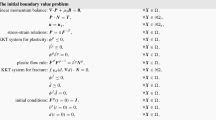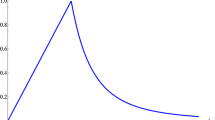Abstract
Ductile fracture using meshless Galerkin method is studied. We use well-known Gurson-Tvergaard-Needleman (GTN) in combination with visibility method. The GTN model is used in the bulk and when certain damage threshold is reached, discrete crack is introduced by taking advantage of the visibility method. The visibility criterion that modifies the particle connectivity based on evolving crack surface morphology is used. We demonstrate the applicability of meshless method to ductile fracture for several problems.
Similar content being viewed by others
References
Zahoor A (1991) Ductile fracture handbook, vol. 3. Novotech
Bazant ZP (2001) Scaling of failure of beams, frames and plates with softening hinges. Meccanica 36:67–77
Krivtsov AM (2003) Molecular dynamics simulation of impact fracture in polycrystalline materials. Meccanica 38:61–70
Hawthorne HM, Xie Y (2001) An attempt to evaluate cohesion in wc/co/cr coatings by controlled scratching. Meccanica 36:675–682
Mc Clintock FA (1968) A criterion for ductile fracture by the growth of holes. J Appl Mech 35:363–371
Rice JR, Tracey DM (1969) On the ductile enlargement of voids in triaxial stress fields. J Mech Phys Solids 17:201–217
Gurson AL (1977) Continuum theory of ductile rupture by void nucleation and growth: Part l. Yield criteria and flow rules for porous ductile media. ASME J Eng Mater Technol 99
Tvergaard V (1981) Influence of voids on shear band instabilities under plane strain condition. Int J Fract Mech 17:389–407
Tvergaard V (1982) On localization in ductile materials containing spherical voids. Int J Fract Mech 18:237–252
Tvergaard V, Needleman A (1984) Analysis of the cup-cone fracture in a round tensile bar. Acta Metall 32:157–169
Pardoen T, Hutchinson JW (2000) An extended model for void growth and coalescence. J Mech Phys Solids 48:2467–2512
Roychowdhury S, Roy YDA, Dodds RH Jr (2002) Ductile tearing in thin aluminum panels: experiments and analysis using large displacement, 3-d surface cohesive elements. Int J Solids Struct 69:983–1002
Besson J, Steglich D, Brocks W (2001) Modelling of crack growth in round bars and plane strain specimens. Int J Solids Struct 38:8259–8284
Xia L, Shih F, Hutchinson JW (1995) A computational approach to ductile crack growth under large scale yielding conditions. J Mech Phys Solids 43:389–413
Kikuchi M (2006) Dimple fracture simulation of fracture specimen under different constraint conditions. Comput Model Eng Sci 11:49–59
Atluri SN, Zhu T (1998) A new meshless local Petrov-Galerkin (mlpg) approach in computational mechanics. Comput Mech 22:117–127
Atluri SN, Zhu T (2000) The meshless local Petrov-Galerkin (mlpg) approach for solving problems in elasto-statics. Comput Mech 25:169–179
Le Phong BE, Rabczuk T, Nam M-D, Tran-Cong T (2010) A moving local irbfn based Galerkin meshless method. Comput Model Eng Sci 66:25–52
Atluri SN (2002) The meshless local Petrov-Galerkin (MLPG) method. Tech Science Press, Duluth
Akbari A, Bagri R, Bordas SPA, Rabczuk T (2010) Analysis of thermoelastic waves in a twodimensional functionally graded materials domain by the meshless local Petrov Galerkin (mlpg) method. Comput Model Eng Sci 65:27–74
Onate E, Idelson S, Zienkievicz O, Taylor RL (1996) A finite point method in computational mechanics: Applications to convective transport and fluid flow. Int J Numer Methods Eng 39:3839–3866
Rabczuk T, Eibl J (2003) Simulation of high velocity concrete fragmentation using sph/mlsph. Int J Numer Methods Eng 56:1421–1444
Rabczuk T, Eibl J, Stempniewski L (2004) Numerical analysis of high speed concrete fragmentation using a meshfree Lagrangian method. Eng Fract Mech 71(4–6):547–556
Rabczuk T, Eibl J (2006) Modelling dynamic failure of concrete with meshfree methods. Int J Impact Eng 32(11):1878–1897
Rabczuk T, Belytschko T (2006) Application of particle methods to static fracture of reinforced concrete structures. Int J Fract 137(1–4):19–49
Monaghan JJ (1994) Simulating free surface flows with sph. J Comput Phys 110:399–406
Belytschko T, Lu YY, Gu L (1994) Element-free Galerkin methods. Int J Numer Methods Eng 37:229–256
Li S, Simonson BC (2003) Meshfree simulation of ductile crack propagation. Int J Comput Methods Eng Sci Mech 6:1–19
Le Phong BE, Rabczuk T, Nam M-D, Tran-Cong T (2010) A moving irbfn based integration-free meshless method. Comput Model Eng Sci 61:63–109
Swegle JW, Hicks DL, Attaway SW (1995) Smoothed particle hydrodynamics stability analysis. J Comput Phys 116:123–134
Antoci C, Gallati M, Sibilla S (2007) Numerical simulation of fluid-structure interaction by sph. Comput Struct 85(11–14):879–890
Vavourakis V, Polyzos D (2007) A mlpg4 (lbie) formulation in elastostatics. Comput Mater Continua 5(3):185–196
Randles PW, Libersky L (2000) Normalized sph with stress points. Int J Numer Methods Eng 48:1445–1461
Belytschko T, Lu YY (1995) Element-free Galerkin methods for static and dynamic fracture. Int J Solids Struct 32:2547–2570
Belytschko T, Tabbara M (1996) Dynamic fracture using element-free Galerkin methods. Int J Numer Methods Eng 39(6):923–938
Bordas S, Rabczuk T, Nguyen-Xuan H, Natarajan S, Bog T, Phu NV, Minh QD, Vinh HN (2010) Strain smoothing in fem and xfem. Comput Struct 88:1419–1443
Rabczuk T, Belytschko T (2004) Cracking particles: A simplified meshfree method for arbitrary evolving cracks. Int J Numer Methods Eng 61(13):2316–2343
Rabczuk T, Zi G (2007) A meshfree method based on the local partition of unity for cohesive cracks. Comput Mech 39(6):743–760
Ventura G, Xu J, Belytschko T (2002) A vector level set method and new discontinuity approximation for crack growth by efg. Int J Numer Methods Eng 54(6):923–944
Zi G, Rabczuk T, Wall W (2007) Extended meshfree methods without branch enrichment for cohesive cracks. Comput Mech 40(2):367–382
Hildebrand G (2009) Fracture analysis using an enriched meshless method. Meccanica 44:535–545
Rabczuk T, Areias PMA (2006) A new approach for modelling slip lines in geological materials with cohesive models. Int J Numer Anal Methods Geomech 30(11):1159–1172
Fatemi J, Van Keulen F, Onck PR (2002) Generalized continuum theories: Application to stress analysis in bone. Meccanica 37:385–396
Rabczuk T, Zi G, Gerstenberger A, Wall WA (2008) A new crack tip element for the phantom node method with arbitrary cohesive cracks. Int J Numer Methods Eng 75:577–599
Taylor M, Cotton J, Zioupos P (2002) Finite element simulation of the fatigue behaviour of cancellous bone. Meccanica 37:419–429
Rabczuk T, Song J-H, Belytschko T (2009) Simulations of instability in dynamic fracture by the cracking particles method. Eng Fract Mech 76:730–741
Ramtani S, Zidi M (2002) Damage-bone remodelling theory: An extension to anisotropic damage. Meccanica 37:355–363
Doblare M, Garcia JM, Cegonino J (2002) Development of an internal bone remodelling theory and applications to some problems in orthopaedic biomechanics. Meccanica 37:365–374
Rabczuk T, Belytschko T (2007) A three dimensional large deformation meshfree method for arbitrary evolving cracks. Comput Methods Appl Mech Eng 196:2777–2799
Rabczuk T, Bordas S, Zi G (2007) A three dimensional meshfree method for static and dynamic multiple crack nucleation/propagation with crack path continuity. Comput Mech 40(3):473–495
Rabczuk T, Zi G, Bordas S, Nguyen-Xuan H (2008) A geometrically non-linear three dimensional cohesive crack method for reinforced concrete structures. Eng Fract Mech 75:4740–4758
Rabczuk T, Zi G, Bordas S, Nguyen-Xuan H (2010) A simple and robust three-dimensional cracking-particle method without enrichment. Comput Methods Appl Mech Eng 199:2437–2455
Rabczuk T, Bordas S, Zi G (2010) On three-dimensional modelling of crack growth using partition of unity methods. Comput Struct 88:1391–1411
Rabczuk T, Areias PMA, Belytschko T (2007) A meshfree thin shell method for non-linear dynamic fracture. Int J Numer Methods Eng 72(5):524–548
Rabczuk T, Areias P (2006) A meshfree thin shell for arbitrary evolving cracks based on an extrinsic basis. Comput Model Eng Sci 16(2):115–130
Rabczuk T, Gracie R, Song J-H, Belytschko T (2010) Immersed particle method for fluid-structure interaction. Int J Numer Methods Eng 81:48–71
Liu WK, Hao S, Belytschko T (1999) Multiple scale meshfree methods for damage fracture and localization. Comput Mater Sci 16(1–4):197–205
Hao S, Liu WK, Chang CT (2000) Computer implementation of damage models by finite element and meshfree methods. Comput Methods Appl Mech Eng 187(3–4):401–440
Hao S, Liu WK, Qian D (2000) Localization-induced band and cohesive model. J Appl Mech 67(4):803–812
Aquaro D (2006) Erosion due to the impact of solid particles of materials resistant at high temperature. Meccanica 41:539–551
Rabczuk T, Samaniego E (2008) Discontinuous modelling of shear bands using adaptive meshfree methods. Comput Methods Appl Mech Eng 197:641–658
Rabczuk T, Areias PMA, Belytschko T (2007) A simplified mesh-free method for shear bands with cohesive surfaces. Int J Numer Methods Eng 69(5):993–1021
Batra RC, Lear M (2004) Simulation of brittle and ductile fracture in an impact loaded prenotched plate. Int J Fract 126:179–203
Batra RC, Ravisankar M (2000) Three-dimensional numerical simulation of the Kalthoff experiment. Int J Fract 105:161–186
Batra RC, Nechitalio N (1997) Analysis of failure modes in impulsively loaded pre-notched plates. Int J Plast 11:291–308
Belytschko T, Krongauz Y, Organ D, Fleming M, Krysl P (1996) Meshless methods: An overview and recent developments. Comput Methods Appl Mech Eng 139:3–47
Nguyen VP, Rabczuk T, Bordas S, Duflot M (2008) Meshless methods: A review and computer implementation aspects. Math Comput Simul 79:763–813
Liu WK, Jun S, Zhang YF (1995) Reproducing kernel particle methods. Int J Numer Methods Eng 20:1081–1106
Chen J-S, Wu C-T, Yoon S, You YS (2001) A stabilized conforming nodal integration for Galerkin mesh-free method. Int J Numer Methods Eng 50:435–466
You Y, Chen JS, Voth TE (2002) Characteristics of semi- and full discretization of stabilized Galerkin meshfree method. Finite Elem Anal Des 38:999–1012
Rabczuk T, Belytschko T, Xiao SP (2004) Stable particle methods based on Lagrangian kernels. Comput Methods Appl Mech Eng 193:1035–1063
Tvergaard V (1990) Material failure by void growth to coalescence. Adv Appl Mech 27:83–151
Needleman A, Tvergaard V (1987) An analysis of ductile rupture modes at a crack tip. J Mech Phys Solids 35:151–183
Chu CC, Needleman A (1980) Void nucleation effects in biaxially stretched sheets. J Eng Mater Technol 102:249–256
Joyce JA, Hacket EM (1994) Development of an engineering definition of the extent of j-controlled crack growth. In: Blaut JG, Schwalbe KH (eds) Defect assessment of components-fundamentals and application, ESIS/EGF9. Mechanical Engineering Publications, London, pp 233–249
Joyce JA, Link RE (1994) Effects of constraint on upper shelf fracture toughness. In: Newman JC Jr, Reuter WG, Underwood JH (eds) Fracture mechanics, ASTM STP 1256, vol 26. American Society for Testing Materials
Xia L, Shih F (1995) Ductile crack growth-I. A numerical study using computational cells with microstructurally-based length scales. J Mech Phys Solids 43:233–259
Rabczuk T, Belytschko T (2005) Adaptivity for structured meshfree particle methods in 2d and 3d. Int J Numer Methods Eng 63(11):1559–1582
Gunther FC, Liu WK (1998) Implementation of boundary conditions for meshless methods. Comput Methods Appl Mech Eng 163:205–230
Oh C, Kima Y-J, Baekb J-H, Kimb Y-P, Kim W (2007) A phenomenological model of ductile fracture for api x65 steel. Int J Mech Sci 49:1399–1412




